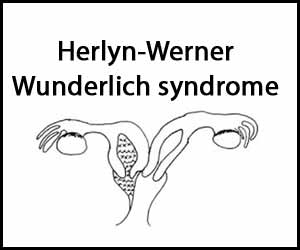- Home
- Editorial
- News
- Practice Guidelines
- Anesthesiology Guidelines
- Cancer Guidelines
- Cardiac Sciences Guidelines
- Critical Care Guidelines
- Dentistry Guidelines
- Dermatology Guidelines
- Diabetes and Endo Guidelines
- Diagnostics Guidelines
- ENT Guidelines
- Featured Practice Guidelines
- Gastroenterology Guidelines
- Geriatrics Guidelines
- Medicine Guidelines
- Nephrology Guidelines
- Neurosciences Guidelines
- Obs and Gynae Guidelines
- Ophthalmology Guidelines
- Orthopaedics Guidelines
- Paediatrics Guidelines
- Psychiatry Guidelines
- Pulmonology Guidelines
- Radiology Guidelines
- Surgery Guidelines
- Urology Guidelines
Rare case of Herlyn-Werner-Wunderlich syndrome presenting with dysmenorrhea: a report

Dr Dilruba Sharmen Nishu at Department of Gynaecology and Obstetrics, Cumilla Medical College and Hospital (CuMCH), Cumilla, Bangladesh and associates reported a rare case of Herlyn-Werner-Wunderlich syndrome presenting with dysmenorrhea that has been published in theJournal of Medical Case Reports.
Herlyn-Werner-Wunderlich syndrome is a rare congenital anomaly characterized by uterus didelphys, obstructed hemivagina, and ipsilateral renal agenesis.
A 15-year-old Asian girl presented to the emergency department of Cumilla Medical College and Hospital, Bangladesh, with increasing pain in the right lower abdomen of 3 months’ duration. She experienced severe, colicky pain in the right lower abdomen with the onset of menstruation. Her pain did not radiate and was not associated with fever, vomiting, or urinary complaints. She denied any past medical or surgical history. She had had menarche 3 months earlier and had a regular menstrual cycle with dysmenorrhea and cyclical abdominal pain. For the latter problem, she was prescribed analgesics from a local pharmacy, which resulted in transient improvement of the symptoms. She was born at term of an uncomplicated pregnancy, and she had no family history of congenital diseases. She was not sexually active and did not take contraceptive pills or hormone therapy. She belonged to a middle-class family.
Regarding her developmental history, she achieved neck control at 4 months, sitting at 7 months, walking unsteadily from 13 months, and walking steadily from 20 months. Her weight was 33 kg, and her height was 144 cm, both were below the fifth percentile for her age and sex according to the National Center for Health Statistics, Centers for Disease Control and Prevention, and were normal. Her parents were nonconsanguineous. On the day of admission, she was afebrile, and her vital signs were stable except for mild anemia (pulse 84 beats/minute, blood pressure 125/80 mmHg, anemia +, temperature 98 ° F). The results of her other general physical examinations were unremarkable. Abdominal examination found a tender mass on the right iliac fossa. Per rectal examination revealed a mass in the pouch of Douglas. The patient was admitted to the gynecology department, where she was medicated with drugs (analgesic, omeprazole, paracetamol) for relief of symptoms until an MRI scan was obtained and a corrective surgery planned.
Routine investigations were done. The patient’s complete blood count was within normal limits with a hemoglobin level of 11.1 g/dl and erythrocyte sedimentation rate of 62 mm/first hour. Her white blood cell count was 12 × 109/L with a differential count of 62.5% neutrophils, 29% lymphocytes, and 6.8% monocytes. Her red blood cell (RBC) count was 3.97 × 1012/L. Her platelet count was 431 × 109/L. Routine urine and microscopic examinations showed no features of infection (quantity: sufficient, color: straw, albumin, sugar, and phosphate: nil, pus cells: 4–6/high-power field [HPF], epithelial cells: 3–4/HPF, RBCs: nil). Further evaluation with ultrasound showed distended endometrial cavity filled with complex fluid with low-level internal echoes and nonvisualization of the right kidney. A provisional diagnosis of uterus didelphys, hematometra, hematocolpos, and agenesis of the right kidney was made.
Pelvic MRI and intravenous urography (IVU) were performed for further evaluation. Pelvic MRI showed two separate endometrial stripes urrounded by endometrium and a muscular layer. The right endometrial cavity and cervix were distended with blood, possibly owing to obstructed right hemivagina. The right kidney was absent. An MRI finding was suggestive of uterine didelphys with right-sided hematometra resulting from obstructed hemivagina with ipsilateral agenesis of the right kidney (HWW syndrome). IVU revealed an absent or nonexcreting right kidney and normal excreting left kidney. Identification and resection of the vaginal septum were done and reached up to the right cervix for the drainage of tarry blood. Thus vaginal canal was reconstructed. There were no perioperative or postoperative complications. She was discharged 5 days after surgery.
She was seen in regular follow-up. She first came for follow-up 7 days after discharge. She was in good health and had no new complaints. Vaginal examination revealed a healthy wound with no adhesion of the vaginal wall. Thus, her recovery was uneventful. Later, she also informed us that she had started regular menstruation without any pain 30 days after the operation. She visited the hospital for another two follow-up visits almost 1 month apart. Her menstrual cycle was normal, and she had no dysmenorrhea or any other complaints.
Journal Information- Journal of Medical Case Reports
For more details click on the link: https://doi.org/10.1186/s13256-019-2258-6

Disclaimer: This site is primarily intended for healthcare professionals. Any content/information on this website does not replace the advice of medical and/or health professionals and should not be construed as medical/diagnostic advice/endorsement or prescription. Use of this site is subject to our terms of use, privacy policy, advertisement policy. © 2020 Minerva Medical Treatment Pvt Ltd